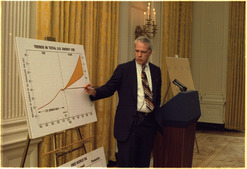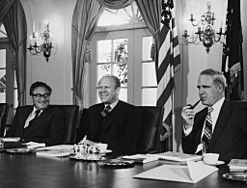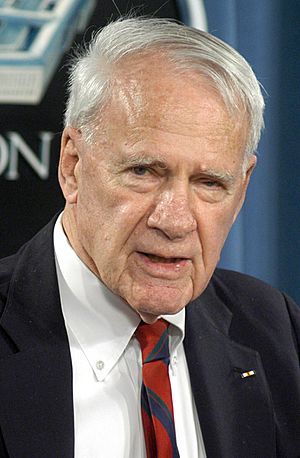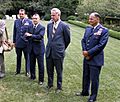James R. Schlesinger facts for kids
Quick facts for kids
James R. Schlesinger
|
|
|---|---|
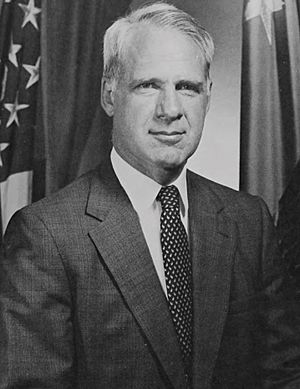
Official portrait
|
|
| 1st Secretary of Energy | |
| In office August 9, 1977 – August 23, 1979 |
|
| President | Jimmy Carter |
| Preceded by | John F. O'Leary (FEA) |
| Succeeded by | Charles Duncan Jr. |
| 12th Secretary of Defense | |
| In office July 2, 1973 – November 19, 1975 |
|
| President | Richard Nixon Gerald Ford |
| Preceded by | Elliot Richardson |
| Succeeded by | Donald Rumsfeld |
| 9th Director of Central Intelligence | |
| In office February 2, 1973 – July 2, 1973 |
|
| President | Richard Nixon |
| Deputy | Vernon A. Walters |
| Preceded by | Richard Helms |
| Succeeded by | Vernon A. Walters (acting) |
| Chair of the Atomic Energy Commission | |
| In office August 17, 1971 – January 26, 1973 |
|
| President | Richard Nixon |
| Preceded by | Glenn Seaborg |
| Succeeded by | Dixy Lee Ray |
| Personal details | |
| Born |
James Rodney Schlesinger
February 15, 1929 New York City, New York, U.S. |
| Died | March 27, 2014 (aged 85) Baltimore, Maryland, U.S. |
| Resting place | Ferncliff Cemetery, Springfield, Ohio, U.S. |
| Political party | Republican |
| Spouse |
Rachel Line Mellinger
(m. 1954; died 1995) |
| Children | 8 |
| Education | Harvard University (BA, MA, PhD) |
James Rodney Schlesinger (February 15, 1929 – March 27, 2014) was an American economist and public servant. He held important roles in the U.S. government. He is best known for being the Secretary of Defense from 1973 to 1975. He served under Presidents Richard Nixon and Gerald Ford.
Before this, he led the Atomic Energy Commission (AEC) from 1971 to 1973. He was also the CIA Director for a few months in 1973. Later, he became America's first Secretary of Energy under President Jimmy Carter in 1977, serving until 1979. As Secretary of Defense, he supported the creation of important military aircraft. These included the A-10 and the F-16 fighter jets.
Contents
Early Life and Education
James Rodney Schlesinger was born in New York City. His parents were Rhea Lillian and Julius Schlesinger. His mother was from Lithuania, and his father's family was from Austria. He became a Lutheran in his early twenties.
Schlesinger went to the Horace Mann School. Then he studied at Harvard University. He earned three degrees there: a bachelor's (1950), a master's (1952), and a PhD (1956) in economics. From 1955 to 1963, he taught economics at the University of Virginia. In 1963, he joined the RAND Corporation. He worked there until 1969, leading strategic studies in his later years.
Joining the Nixon Administration
In 1969, Schlesinger started working for President Nixon's government. He became an assistant director at the Bureau of the Budget. He spent most of his time on defense issues. In 1971, President Nixon made him chairman of the Atomic Energy Commission (AEC). He worked to improve how the AEC managed its tasks.
Leading the CIA
Schlesinger was the CIA Director from February 2, 1973, to July 2, 1973. He was in this role for only five months. During his time, he reduced the number of staff at the CIA by 7%. He was seen as someone who wanted the agency to follow President Nixon's orders more closely.
Secretary of Defense (1973–1975)
Schlesinger became the Secretary of Defense on July 2, 1973, when he was 44 years old. He had a lot of experience in national security. This came from his time as a professor, researcher, and government official.
Modernizing Defense Strategy
As Secretary of Defense, Schlesinger had several goals. He wanted to keep a "strong defense establishment." He also aimed to "assure the military balance" for peace. He believed military members deserved "respect, dignity and support." He also wanted to use the nation's money wisely.
Schlesinger felt that older defense plans needed updating. This was because the Soviet Union had become very strong in nuclear weapons. He believed that having strong defense abilities was key to stopping attacks. He also thought that the U.S. needed to be able to respond to nuclear attacks without causing total destruction. This was called a "flexible response" nuclear strategy. He wanted the U.S. to be able to hit specific military targets. This would avoid harming large cities.
He also focused on the North Atlantic Treaty Organization. He wanted to make NATO's regular military forces stronger. He believed NATO should not rely only on nuclear weapons. He encouraged NATO countries to spend more on defense. He also pushed for better equipment for NATO forces.
Dealing with Major Crises

Schlesinger faced several big challenges during his time. In October 1973, the Yom Kippur War began. Arab countries attacked Israel. The U.S. started an airlift to send supplies to Israel. This happened when Israel faced strong military forces. Schlesinger said the U.S. helped because Israel needed support.
Another crisis happened in July 1974. Turkish forces invaded Cyprus. This was due to concerns about the Turkish community there. The U.S. Congress stopped military aid to Turkey for five years. This was because Turkey used U.S.-supplied equipment in the invasion. President Ford and Secretary of State Henry Kissinger wanted to continue aid. But Congress disagreed.
Ending the Vietnam War Era

The final part of the Vietnam War happened while Schlesinger was Secretary of Defense. U.S. combat forces had left South Vietnam in 1973. But the U.S. still had a military presence in Southeast Asia. When North Vietnam attacked in 1975, the U.S. could not do much to help South Vietnam. North Vietnam captured Saigon in April 1975. Schlesinger announced the evacuation of the last U.S. personnel from Saigon.
In May 1975, Khmer Rouge forces captured the U.S. ship Mayaguez. The U.S. responded by bombing military sites in Cambodia. Marines also rescued the crew from an island. The crew was saved, but 41 U.S. military members died. Most Americans supported this strong action.
Defense Budget Challenges
Schlesinger worked hard to get more money for the Defense budget. He wanted to build up U.S. military forces. He pointed out that the Defense budget had been cut a lot since 1968. He noted that military spending was at its lowest percentage of the nation's economy since before the Korean War. He argued for more funds because the Soviet Union was improving its weapons. However, he had little success in getting large budget increases from Congress.
Leaving the Defense Department
President Ford dismissed Schlesinger in November 1975. This was due to disagreements over defense budgets. There were also differences with Secretary of State Henry Kissinger. Schlesinger wanted strong defenses and was cautious about arms control agreements. He also had a direct way of speaking that sometimes strained his relations with Congress.
Despite these issues, Schlesinger was seen as a very capable Secretary of Defense. He was a deep thinker about nuclear strategy. He was determined that the U.S. should not fall behind the Soviet Union. He worked to modernize defense policies and programs. He got along well with military leaders.
Secretary of Energy (1977–1979)
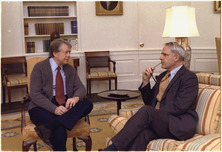
After leaving the Pentagon, Schlesinger continued to speak about national security. He talked about the Soviet threat and the need for strong U.S. defenses. In 1977, President Jimmy Carter appointed Schlesinger as his special adviser on energy. Later, in October 1977, he became the first Secretary of Energy.
As Energy Secretary, Schlesinger started a program to study the effects of carbon dioxide. He also brought together the energy duties of over 50 government agencies. In July 1979, President Carter replaced him. This was part of a larger change in Carter's cabinet.
Later Activities and Contributions
After leaving government, Schlesinger continued to write and speak. He worked as an adviser for a financial company. He also advised presidential candidate Richard Gephardt in 1988.
In 1995, he chaired the National Academy of Public Administration. They wrote a report about opening up the GPS to private companies. In 2002, he supported creating a commission to investigate the 9/11 attacks.
President George W. Bush appointed him to the Homeland Security Advisory Council in 2002. He also advised the United States Department of Defense. In 2004, he led a panel to review military detention operations.
In 2006, he met with other former Secretaries of Defense and State at the White House. They discussed U.S. foreign policy. He also joined the Arms Control and Nonproliferation Advisory Board. In 2007, NASA appointed him to lead an advisory board for GPS.
In 2008, Defense Secretary Robert Gates asked Schlesinger to lead a task force. This group worked to improve control over nuclear weapons. Schlesinger also served on the boards of several companies and organizations. He wrote articles expressing skepticism about global warming.
Raising Awareness of Peak Oil
Schlesinger also spoke about the issue of peak oil. This is the point when oil production reaches its highest level and then starts to decline. In 2007, he said that oil industry leaders privately agreed that the world was close to peak oil production. In 2010, he stated that the debate about peak oil was over. He warned that not taking action could be a major problem.
Personal Life
In 1954, James Schlesinger married Rachel Line Mellinger. They had eight children together. Rachel Schlesinger was a talented violinist. She helped raise money to build a performing arts center in Virginia. She passed away in 1995. Dr. Schlesinger donated money to have the center named the Rachel M. Schlesinger Concert Hall and Arts Center in her memory. It opened in 2001.
Schlesinger continued to serve on government advisory boards until shortly before his death at age 85. He was buried at Ferncliff Cemetery in Springfield, Ohio.
Selected Publications
- Schlesinger, James R. America at Century's End. New York: Columbia University Press, 1989. ISBN: 0-231-06922-7
- Schlesinger, James R. American Security and Energy Policy. Manhattan, Kan: Kansas State University, 1980.
- Schlesinger, James R. Defense Planning and Budgeting: The Issue of Centralized Control. Washington: Industrial College of the Armed Forces, 1968.
- Schlesinger, James R. The Political Economy of National Security; A Study of the Economic Aspects of the Contemporary Power Struggle. New York: Praeger, 1960.
Images for kids
See also
 In Spanish: James Schlesinger para niños
In Spanish: James Schlesinger para niños



